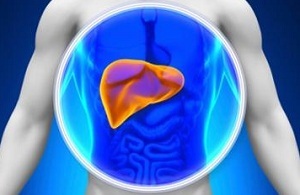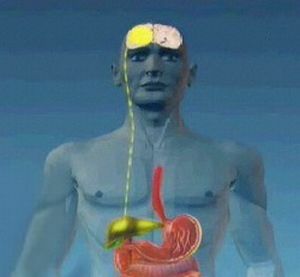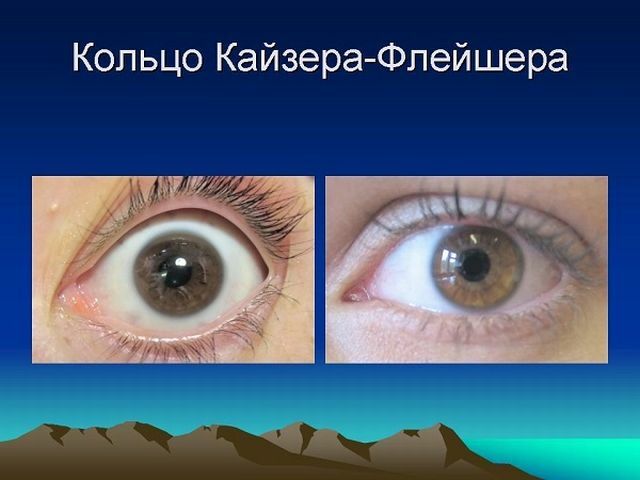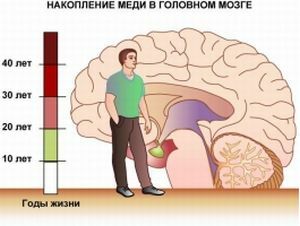 Wilson-Konovalov disease( hepatocerebral dystrophy) is a disease that occurs due to a violation of copper metabolism in the body, namely, its excess is formed in organs such as the liver, kidneys and brain. Also, the toxic effect of copper has an effect on the human nervous system.
Wilson-Konovalov disease( hepatocerebral dystrophy) is a disease that occurs due to a violation of copper metabolism in the body, namely, its excess is formed in organs such as the liver, kidneys and brain. Also, the toxic effect of copper has an effect on the human nervous system.
Often the first symptoms of Wilson Konovalov's disease appear in the adolescent or at the age of twenty, although there are cases when the disease is diagnosed much later.
This disease is congenital, that is, parents act as carriers of mutating genes that are passed on to the child. At the heart of the mechanism of inheritance is the genetic flaw of the substance, which is responsible for the exchange process of copper in the body.
Because this process is broken, copper accumulates in the body and has a detrimental effect on internal organs and nervous system, damaging them.
The nature of the clinical picture
All symptoms of the disease can be divided into several groups.
Lesion of the liver:
- jaundice - skin, mucous membranes and eyeballs acquire a yellowish tinge;
- the liver increases in size , there is an unpleasant feeling of heaviness, pain under the right rib;
- the liver ceases to perform the detoxification function of , the organism is poisoned;
- body temperature rises sometimes up to 39 degrees.
Disorders of the nervous system and mental disorders:
- hyperkinesises occur - the patient commits involuntary repetitive movements with arms and legs;

- may come immobilization ;
- develops seizure attacks of due to intensive activation of brain cells, consciousness becomes fuzzy, sometimes fainting occurs;
- is disrupted swallowing reflex ;
- occurs in the speech due to innervation of the tongue, soft palate, lips, speech becomes vague, sounds and words are pronounced with difficulty;
- disrupts the coordination of movements of ;
- marked depressive states and psychoses , psychosis will necessarily be accompanied by hallucinatory delusions;
- increases the aggressiveness level of ;
- there is a tremor of hands, feet and head , which can take place at rest, as well as involuntary grimacing;
- is broken sleep ;
- memory deteriorates ;
- handwriting changes .
It should be noted that mental disorders are noted in 20% of all patients.
Lesion of internal organs and systems:
- disorders in endocrine system - sexual desire decreases, potency worsens, in some cases, infertility;
- kidney damage ;
- damage to the circulatory system , anemia, disturbance of the blood clotting process;
- disorder in the bone system - osteoporosis develops, so frequent fractures of bones occur;
- cornea damage - a Kaiser-Fleischer ring appears, which has a golden brown color;
- dermatological pathology - the skin color changes, it begins to peel off and becomes dry;
- develops the cataract .

Forms of the disease
There are 5 forms of the disease:
- Abdominal - lesion of liver tissue, leading to premature death.
- Rigid - arrhythmic hyperkinetic - the disease develops reactively, while the musculoskeletal apparatus, the heart muscle, the nervous system are affected. A few years after the onset of the development of the disease, death may occur.
- Asthmatic-rigid is the most common type, subfebrile body temperature holds, muscle contractions with tremor are observed, the liver is affected.
- Tremorous - develops from twenty to thirty years, proceeds for a long time, is characterized by tremor of arms and legs, gradually there are muscle contractions, speech function is disrupted.
- Extrapyramidal - cortical - occurs infrequently, lasts on average up to eight years, is characterized by typical manifestations and gradual occurrence of paralysis of the extremities. At the end of the eight-year period, a person dies.
Diagnosis of
The diagnosis of Wilson Konovalov's disease is carried out using the following methods:
- analysis of the patient's medical history and complaints - when the first signs were found, during the transition period or immediately after birth, which signs are more pronounced;
- analysis of a life history of - whether the patient suffered from liver, GIT, poisoning;
- collection of a family history of - whether any of the blood relatives were ill;

- medical examination - abdominal palpation for the detection of soreness and yellow skin tone;
- clinical blood test - defines such pathologies as anemia, leukocytosis;
- biochemical blood test - a study of the liver, pancreas, level of essential trace elements contained in the blood;
- coagulogram - determination of the property of clotting of blood;
- urine analysis - monitoring the state of the genitourinary system;
- blood test for the presence of the hepatitis virus ;
- coprogram - general stool analysis, as well as detection of the presence of helminths;
- genotyping is the definition of a gene mutation that triggered the disease;
- Ultrasound of the abdomen for assessing liver changes and the status of other vital organs;
- elastrography - analysis of liver tissue for the differentiation of Wilson-Konovalov's disease from a pathology such as cirrhosis;
- electroencephalography and computed tomography - an analysis of electrical activity in the brain in the event of damage to the nervous system;
- electrocardiography - detection of a defect in the heart muscle.

In the photo, the Kaiser-Fleischer ring is the main symptom of Wilson Konovalov's disease
The main symptoms in the disease that determine the diagnosis - lesions of the liver, nervous system, visual organs - a golden brown ring around the iris.
Approach to therapy
 The main method of therapy is conservative. Therapy will be aimed at reducing the concentration of copper in the human body. Treatment should begin immediately after the diagnosis is made and do not stop until the end of the patient's life. It consists in taking medications, to cancel or reduce the dose of which without the knowledge of the doctor is strictly prohibited.
The main method of therapy is conservative. Therapy will be aimed at reducing the concentration of copper in the human body. Treatment should begin immediately after the diagnosis is made and do not stop until the end of the patient's life. It consists in taking medications, to cancel or reduce the dose of which without the knowledge of the doctor is strictly prohibited.
Drug medications are selected individually for each individual case, taking into account the symptoms and the form of the disease.
Among the drugs that are used to treat Wilson-Konovalov's disease are the following:
- chelates - neutralize and lower the level of copper in the body;
- blockers - prevent copper from entering the blood from the intestines and stomach;
- immunosuppression - suppress immunity, which is activated in case of self-poisoning of the body;
- anti-inflammatory drugs - stop inflammation in the liver;
- group of multivitamins, especially vitamin B6 ;
- zinc preparations - copper ingestion is reduced;
- preparations for treating neurological pathologies of , for example, disturbances of the swallowing reflex, speech, coordination of movements, sleep, aggression, memory impairment. Because they cause rather complicated side effects, along with them
 are prescribed fortifying agents and vitamin complexes;
are prescribed fortifying agents and vitamin complexes; - tremor of limbs and head, and grimacing is treated with drugs Lorazepam and Clonazepam ;
- for the treatment of depression are prescribed antidepressants ;
- hepatoprotectors - substances that normalize the activity of liver cells;
- cholagogue preparations - increase the excretion of bile from the body;
- antioxidants - neutralize the action of toxic toxins.
In psychoses, a psychiatric consultation is required first. Surgical intervention is applied in the event that the drug treatment failed and liver transplantation is required.
Patients should limit their eating habits with high concentrations of copper. Among such products:
- meat;
- fungi;
- seafood;
- soybean;
- nuts;
- dried fruits;
- cocoa;
- chocolate;
- beans.
Complications and consequences of
If therapy is not scheduled in time, the disease leads to death. Among the standard complications of hepatocerebral dystrophy can be identified:
- Cirrhosis - occurs at the last stage of the disease.

- Liver failure - liver dysfunction due to cell destruction.
- Ascites is a collection of fluid in the abdominal cavity.
- Peritonitis - inflammation of the peritoneum.
- Varicose veins - occurs due to increased pressure in the vessels.
- Extension of the esophagus of the , resulting in internal bleeding. It can be determined by such signs: vomiting with blood, feces stains in an unnatural dark color, blood pressure decreases, cardiac contractions become more frequent.
- Neuropsychic syndrome - manifests confusion, there are behavioral disorders, neuromuscular pathologies.
- Liver tumor , is formed due to systematic damage. Neoplasm very quickly progresses and practically does not give in to treatment.
- Renal failure - occurs because of a violation of filtration in the blood of poisonous substances.
- Pulmonary-pulmonary syndrome - a decrease in the oxygen content in the blood, as a consequence of the violation of blood circulation in the lungs.
- Diseases of the digestive tract .Infertility, impotence .
Prevention of complications
Because the disease is congenital, prevention methods will be to prevent the development of complications. What in this case should be performed:
- visit a specialist for examination at least twice a year, if there are impairments, then more often;
- avoid contact with harmful domestic and industrial irritants, do not use drugs dangerous for the liver;
- lead a healthy life, but do not perform heavy physical exertion;
- abandon all bad habits;
- take vitamins;
- does not trigger liver and gastrointestinal diseases such as hepatitis, gastritis, stomach ulcer and duodenal ulcer, inflammation of the pancreas and gallbladder.

In general, it can be said that the prognosis for Wilson-Konovalov disease will be quite positive, the person remains able-bodied and does not require outside help. But such a result is possible only if the disease is diagnosed in time and the person will undergo a full-fledged qualified treatment.
It is possible to speak about an unfavorable prognosis in those cases when the patient is diagnosed with acute hepatic insufficiency and a pathology of the circulatory system like hemolysis, the process of erythrocyte damage.



